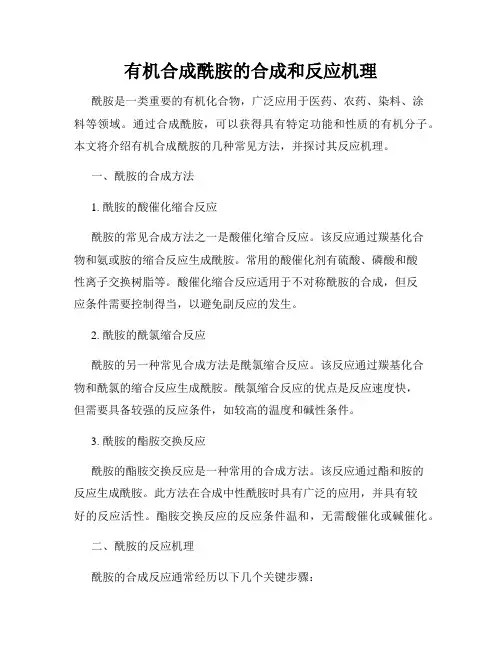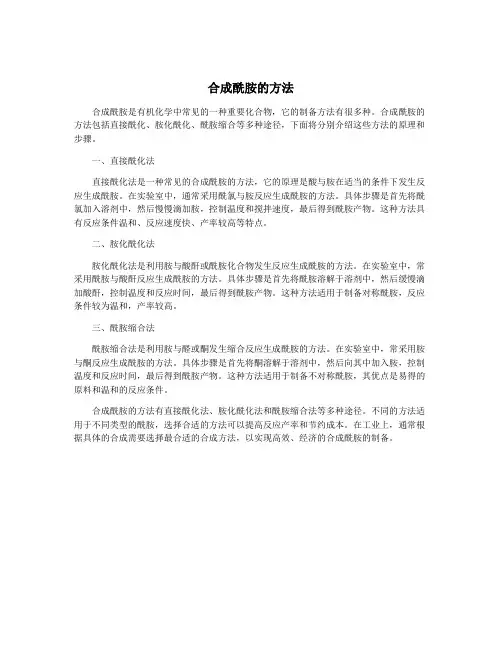药明康德酰胺的合成
- 格式:ppt
- 大小:1.65 MB
- 文档页数:61


经典化学合成反应标准操作酯交换为酰胺编者:杜晓行药明康德新药开发有限公司化学合成部目录1.前言 (2)2.酯交换为酰胺 (2)3.酯交换为N-取代酰胺 (2)1.前言酯和氨水反应可以很方便地得到酰胺。
N-取代酰胺一般可以利用相应的胺与酯直接反应得到,在有些条件下,需要有铝试剂的存在反应才能够顺利进行。
2.酯与氨交换一般酯的氨解通过氨的醇溶液或氨水来进行。
氨的醇溶剂氨解反应可通过加入适量的甲醇钠和氰化钠来催化。
用氨水直接氨解一般需要加热(当该反应温度到100度时,一定要用高压釜做这一反应),这类反应一般可以通过硫酸铜来进行催化。
反应的条件选择主要看酯的活性程度,一般脂肪酸酯的交换要比芳香羧酸酯来得容易,甲酯要比乙酯来得快。
对脂肪酸酯,α位的位阻大小也决定了反应的快慢。
酯通过甲酰胺在乙醇钠的存在下,高温也可得到相应的酰胺。
这一方法对各类的酯都比较有效,只是产品的分离比直接氨解稍微麻烦一些,但反应较快。
另外近年来,AlMe 3-NH 4Cl 或Me 2AlNH 2在多官能团及复杂化合物的合成中用的较多,该方法条件较强,各类酯都能很快的氨解。
其缺点是AlMe 3易自燃,操作不是太方便。
2.1 氨水用于脂肪羧酸酯氨解示例[1]NO OOOO NO H 2NOO NH OHTo ethyl 5-ethoxycarbonylmethyl-3-methylisoxazole-4-carboxylate (1.00 g, 4.15 mmol) was added an excess of conc. aqueous ammonia (d = 0.88 kg·dm -3, 5.0 cm 3) and EtOH (3.0 cm 3), and the suspension was stirred vigorously at room temperature for 14 h. After this period a white solid had precipitated which was filtered and recrystallized (EtOAc) to yield the desired product as a white solid (0.81 g, 92%).NO OOOO NO HNOOO MeNH 2 / toluenePrepared as described above for ethyl 5-carbamoylmethyl-3-methylisoxazole-4-carboxylate but using methyl-5-ethoxycarbonyl- 3-methylisoxazole-4-carboxylate (1.00 g, 4.15 mmol) and methylamine in toluene (30% w/v, 10.0 cm 3), to yield the desired product as a white solid (0.93 g, 99%).2.2 氨甲醇氨解脂肪羧酸酯示例[2] [3]NH O OCOOEtNH OO CONHMe MeNH / MeOHThe ester (4.11 g, 14 mmol) was dissolved in absol. methanolic ammonia (100 ml, 20 % NH 3), and the solution was allowed to stand at temperature for 3 days, the solvent was then evaporated, and the resulting crystalline was purified by recrystallization.2.3 氨水用于芳香羧酸酯氨解示例[4]NNCONH 2To an autoclave, was added methyl 6-methylniconate (500 g, 3.31 mol), sat. aq. NH 4OH (500 ml) and ethanol (500 ml). After sealing, the reaction was heated to 80℃ for 2 days. The cooled reaction mixture was filtrated, and the filter cake was recrystallized to afford white solid (247 g, 54.8%)。


有机合成酰胺的合成和反应机理酰胺是一类重要的有机化合物,广泛应用于医药、农药、染料、涂料等领域。
通过合成酰胺,可以获得具有特定功能和性质的有机分子。
本文将介绍有机合成酰胺的几种常见方法,并探讨其反应机理。
一、酰胺的合成方法1. 酰胺的酸催化缩合反应酰胺的常见合成方法之一是酸催化缩合反应。
该反应通过羰基化合物和氨或胺的缩合反应生成酰胺。
常用的酸催化剂有硫酸、磷酸和酸性离子交换树脂等。
酸催化缩合反应适用于不对称酰胺的合成,但反应条件需要控制得当,以避免副反应的发生。
2. 酰胺的酰氯缩合反应酰胺的另一种常见合成方法是酰氯缩合反应。
该反应通过羰基化合物和酰氯的缩合反应生成酰胺。
酰氯缩合反应的优点是反应速度快,但需要具备较强的反应条件,如较高的温度和碱性条件。
3. 酰胺的酯胺交换反应酰胺的酯胺交换反应是一种常用的合成方法。
该反应通过酯和胺的反应生成酰胺。
此方法在合成中性酰胺时具有广泛的应用,并具有较好的反应活性。
酯胺交换反应的反应条件温和,无需酸催化或碱催化。
二、酰胺的反应机理酰胺的合成反应通常经历以下几个关键步骤:1. 缩合反应酰胺的合成首先涉及缩合反应,即羰基化合物和氨或胺的缩合。
在酰胺的酸催化缩合反应中,氨或胺中的氢原子会被羰基化合物中的羰基氧原子去质子化,形成中间的羰基中间体。
随后,羰基中间体经过质子化和脱水反应,生成酰胺。
2. 酰氯缩合反应酰胺的酰氯缩合反应是通过羰基化合物和酰氯的缩合反应生成酰胺。
在该反应中,羰基化合物中的羰基氧原子被酰氯中的氯原子取代,形成酰氯中间体。
酰胺的形成通过质子转移和脱氯反应完成。
3. 酯胺交换反应酰胺的酯胺交换反应是通过酯和胺的交换反应生成酰胺。
在该反应中,酯中的酯基被胺中的氨基取代,形成酰胺。
酯胺交换反应可以在中性条件下进行,并且通常伴随着水的生成。
总的来说,有机合成酰胺的方法有多种多样,每种方法都有其适用范围和优缺点。
通过合理选择反应条件和反应物,可以实现高效、高选择性的酰胺合成。

经典化学合成反应标准操作药明康德新药开发有限公司化学合成部编写前言有机合成研究人员在做化学反应经常碰到常规的反应手边没有现成的标准操作步骤而要去查文献,在试同一类反应时,为了寻找各种反应条件方法也得去查资料。
为了提高大家的工作效率,因此化学合成部需要一份《经典合成反应标准操作》。
在这份材料中,我们精选药物化学中各类经典的合成反应,每类反应有什么方法,并通过实际经验对每类反应的各种条件进行点评,供大家在摸索合成条件时进行比较。
同时每种反应的标准操作,均可作为模板套用于书写客户的final report,这样可以大大节省研究人员书写final report的时间,也相应减少在报告中的文法错误。
另外本版是初版,在今后的工作中我们将根据需要修订这份材料。
药明康德新药开发有限公司化学合成部2005-6-28目录1.胺的合成a)还原胺化b)直接烷基化c)腈的还原d)酰胺的还原e)硝基的还原f)叠氮的还原g)Hoffman降解h)羧酸通过Cris 重排2.羧酸衍生物的合成a)酰胺化的反应b)酯化反应c)腈转化为酯和酰胺d)钯催化的插羰反应e)酯交换为酰氨3.羧酸的合成a)醇氧化b)酯水解c)酰胺的水解d)腈的水解e)有机金属试剂的羰基化反应f)芳香甲基的氧化4.醛酮的合成a)Weinreb 酰胺合成醛酮b)醇氧化c)酯的直接还原d)有机金属试剂对腈加成合成酮5.脂肪卤代物的合成a)醇转化为脂肪溴代物通过PBr3 转化通过PPh3 与CBr4 转化HBr直接交换通过相应的氯代物或磺酸酯与LiBr交换、b)醇转化为脂肪氯代物通过SOCl2转化通过PPh3 与CCl4 转化HCl直接交换c)醇转化为脂肪碘代物通过PPh3 与I2 转化通过相应的氯代物或磺酸酯与NaI交换6.芳香卤代物的合成a)Sandermyyer 重氮化卤代b)直接卤代c)杂环的酚羟基或醚的卤代7.醇的合成a)羧酸或酯的还原b)醛酮的还原c)卤代烃的水解.d)吡啶的氧化转位8.酚的合成a)Sandermayer 重氮化反应b)醚的水解c)Bayer-vigerlar 氧化d)硼酸的氧化9.腈的合成a)磺酸酯或卤代烃的取代b)酰胺的脱水c)芳卤代烃的氰基取代10.硝化反应11.醚的合成a)芳香醚的合成酚与烷基卤代烃的直接烷基化Mitsunobu 芳香醚化Buckwald芳香醚化b)脂肪醚的合成醇的醚化12.脲的合成a)胺与异腈酸酯的反应b)用三光气合成脲c)羰基二咪唑(CDI)合成脲d)对硝基苯酚碳酰胺合成脲.13.烯烃的合成a)Wittig 反应b)羟基的消除c)Wittig-Horner 反应合成α,β-不饱和酯14.磺酸及磺酰氯的合成a)氯磺化反应合成磺酰氯b)从硫醇合成磺酰氯c)磺化反应15.氨基酸的合成a)Streck 反应合成b)手性氨基酸的合成16.偶联反应a)Suzuki Couplingb)Buckwald 芳胺化,芳酰胺化、c)Heck 反应17.Mitsunobu 反应a)醇的反转b)胺的取代18.脱羟基反应19.酮还原为亚甲基.20.氨的保护及脱保护策略a)用碳酰胺作保护基b)苄基保护21.醇的保护及脱保护策略a)用硅醚进行保护b)其他醚类保护22.羧基的保护Boc脱保护-------------------------------------------------------------------------------------------------------1格氏反应---------------------------------------------------------------------------------------------------------1 还原胺化---------------------------------------------------------------------------------------------------------2卤化反应---------------------------------------------------------------------------------------------------------2 Suzuki coupling-------------------------------------------------------------------------------------------------2 磺化反应---------------------------------------------------------------------------------------------------------3 酯化反应---------------------------------------------------------------------------------------------------------3 水解反应---------------------------------------------------------------------------------------------------------3 硝化反应---------------------------------------------------------------------------------------------------------4 n-BuLi------------------------------------------------------------------------------------------------------------4 LiAlH4还原-----------------------------------------------------------------------------------------------------4 POCl3的杂环氯代----------------------------------------------------------------------------------------------5 NaH---------------------------------------------------------------------------------------------------------------5 NBS---------------------------------------------------------------------------------------------------------------5 氢化反应---------------------------------------------------------------------------------------------------------6 m-CPBA----------------------------------------------------------------------------------------------------------6 EDC---------------------------------------------------------------------------------------------------------------6 用三光气成脲---------------------------------------------------------------------------------------------------7 芳卤用n-BuLi处理后与Weinreb酰胺成酮-----------------------------------------------------------------7Boc 上保护OHH 2NHO OOO OOO OHN HO OHO O A BTo a solution of A (2.72 g, 13.9 mmol) and tetramethylammonium hydroxide pentahydrate (5.62 g, 31.0 mmol) in acetonitrile (270 mL) was added di-tert-butyldicarbonate (3.79 g; 17.4 mmol) and the resulting solution was allowed to stir 18 h at rt and concentrated. The residue was partitioned between Et2O/H2O; the phases were separated and the aqueous phase extracted twice more with Et2O. The aqueous phase was brought to pH 4 with solid citric acid and extracted with CHCl3 (3.x.100 mL). The organic extracts were combined, dried (Na2SO4) and concentrated to afford 2.58 g (63 percent) B as a white foam.ReturnBoc 脱保护OON HOO OOH 2NTert-Butyl 2-(2-methoxyphenoxy)ethylcarbamate (23.8 g, 89 mmol) in dichloromethane (10 ml) was cooled to 0 deg C and stirred as a mixture of trifluoroacetic acid: dichloromethane (1:1, 40 ml) was added dropwise. The mixture was allowed to warm to rt, stirred for 2 hours and concentrated in vacuo. The residue was taken back up in dichloromethane (100 ml) and the solution was washed with saturated aqueous sodium hydrogen carbonate (3*20 ml) and aqueous sodium hydroxide (10percent, 3*20 ml), dried (Na2SO4), filtered and concentrated in vacuo to provide 2-(2-methoxyphenoxy)ethylamine (13 g, 88percent yield) as a light yellow solid.Return格氏反应NCNNOA stirred mixture of magnesium turnings (23.6 g, 0.98 mol) and Et2O (200 mL) under nitrogen is treated with a crystal of iodine and about 5percent of a solution of bromoethane (56.3 ml, 0.75 mol) in Et2O (375 mL). When the reaction starts, the remainder of the bromoethane solution is added, dropwise at a rate sufficient to maintain a gentle reflux. After the addition, stirring is continued for 1 hour. To this solution ofethylmagnesium bromide was slowly added a solution of 4-cyanopyridine (39 g, 0.375 mol) in Et2O (750 ml). The reaction mixture was warmed at reflux for 12 hours, treated with concentrated H2SO4 (125 ml)/H2O (125 ml), and then washed three times with Et2O (250 ml). The aqueous portion was made basic (PH 9) with 15percent NaOH solution and extracted five times with 250 ml portions of Et2O. The combined Et2O extracts were dried (MgSO4), and the solvent was removed under reduced pressure to afford a brown oil (48.4 g, 95percent).Return还原胺化OHO H 2N+HON HA solution of 2-amino-4-ethylphenol (1.00 g. 7.28 mmol), 2-naphthaldehyde (1.13 g, 7.28 mmol), and p-toluenesulfonic acid (0.05 g) in methanol (50 ML) was stirred at room temp for 24 h. To the resultant solution, sodium borohydride (0.82 g, 22 mmol) was added in small portions. After addition was completed, the mixture was stirred at room temperature for 30 min and concentrated under vacuum. The residue was then subjected to column chromatography on silica gel eluted with 10percent ethyl acetate in hexane and followed by recrystallization (aqueous methanol) yielded 450 mg (22percent) of analytically pure product.Return卤化反应O 2NO 2NBrTo a stirred solution of 8-methyl-1-nitro-naphthalene (10.6g, 56.32 mmol) and iron (III) chloride (0.45 g, 2.77 mmo) in CCl4 (150 ml) heated to 60°C was added dropwise (3.0 ml, 58.23 mmol) of bromine. After one hour, the reaction mixture was poured into saturated NaHCO3 solution, and the layers were separated. The aqueous layer was re-extracted with CH2Cl2. The combined organic layers were dried (MgSO4) and the solvent was removed under reduced pressure. The crude residue was recrystallized from ethanol and the mother liquors were concentrated and then flash chromatographed on silica, eluding hexanes:ethyl acetate (12: 1).Return Suzuki couplingBrBOO NH+NH To a mixture of 4-(4,4,5,5-tetramethyl-[1,3,2]dioxaborolan-2-yl)-1H-indole (2 g, 8.2 mnmol) and3-bromobenzene (0.87 ml, 8.3 mmol) in THF (28 ml) were added palladium catalyst Pd(PPh3)4 (284 mg, 0.25 mmol) and the freshly prepared sodium hydroxide solution (984 mg in 9 ml of water).The system was degassed and then charged with nitrogen for three times. The mixture was stirred under nitrogen at 70 °C oil bath for 6 hours. The reaction solution was cooled to room temperature, diluted with ethyl acetate and separated from water layer. The ethyl acetate solution was washed by brine, dried over Na2SO4 and concentrated. The residue was purified on a silica gel column eluding with hexanes: EtOAc 9:1 to give 1.38 g (78%yield) of 4-phenyl-1H-indole as a colorless liquid.Return 磺化反应NOFFFNOFFFSOClOChlorosulfonic acid (4.66g, 40 mmol) is added dropwise to a cold (0°C) solution of2,3-dihydro-2-trifluoroacetyl-1H-Benz[de]isoquinoline (2.9g, 8 mmol) in chloroform (800 ml). The resulting solution is stirred at 0°C for 30 minutes. The cold bath is then removed and the solution is stirred at room temperature for 1 hour then cautiously poured into ice water. The organic layer is separated, dried over magnesium sulfate and concentrated to afford the title compound. The crude product is purified by column chromatography eluted with 10% acetic ether in petroleum ether (2.36 g, 81% yield).Return酯化反应HOHO O HOOOA mixture of 4-hydroxymethylnaphthoic acid (10 g, 50 mmol), methanol (300 ml), and concentrate H2SO4 (2 ml) was refluxed overnight. The insolubles were filtered off and the filtrate was concentrated. The residue was taken up in ethyl acetate and washed with aqueous NaHCO3 (2*), brine, dried over MgSO4, and concentrated to give a yellow oil. Silica gel column chromatography using ethyl acetate/hexane (1/3) gave the desired product as a yellow oil (3.3 g, 35%yield).Return水解反应OO OHOA solution of 1-Methyl-naphthalene-2-carboxylic acid methyl ester (7.20g, 35mmol) and 2N sodium hydroxide (35ml) in tetrahydrofuran (130ml) was stirred under reflux for 18 hours. The mixture was neutralised using 2N hydrochloric acid, and extracted with dichloromethane (3x). The combined organic solutions were dried (MgSO4), and evaporated under reduced pressure. The crude product was purified by column chromatography on silica gelusing an elution gradient of dichloromethane: methanol (100:0 to 97:3) to afford the title compound as a solid (3.11g, 47.8%yield).Return硝化反应2To a cold (0°C) suspension of 1-methylnaphthalene (5 g, 35.2 mmol) in HNO3 was added H2SO4 (5 ml)dropwise. After stirring the reaction for one hour, the solution was diluted with ethyl acetate and washed with water (3*), aqueous saturated NaHCO3 (2*) and brine, dried over MgSO4, and concentrated. The product was purified by silica gel column chromatography using ethyl acetate: hexane (5: 95) and recrystallized from methanol to give yellow needles (0.22g, 33% yield).Returnn-BuLiEtOCF 3O CF 3O NCTo a dry three-necked round-bottomed flask with an addition funnel and at -78°C under inert atmosphere was charged with anhydrous THF (500 ml). A solution of n-butyllithium (2.5 M in hexane, 88 ml, 220 mmol) was added dropwise followed by addition of a solution of acetonitrile (10.43 ml, 200 mmol) in anhydrous THF (100 ml). The internal temperature was maintained below -70°C during the entire addition process. After 2 hr at -78°C a solution of Trifluoro-acetic acid ethyl ester (14.2 g, 100 mmol) in anhydrous THF (30 ml) was added dropwise and the mixture was stirred for 1.5 hr. To the mixture was added acetic anhydride to quench the reaction. The reaction mixture was allowed to warm up to rt. A precipitate was filtered and the filtrate was concentrated to give a brown oil, which was used in the next step without purification.ReturnLiAlH4还原HOHO O HOHOA solution of 2,3-naphthalenedicarboxylic acid (4.6 g, 0.023 mole) in dry THF (135 ml, warmed to 50° to maintain solution) is added dropwise over 15 minutes to a 1.15 M lithium aluminum hydride solution in THF (45 ml, 0.052 mole). The solution is stirred 3 hours after which TLC indicated consumption of diacid and formation of a new major product. The reaction is quenched carefully with THF-water, then 2N hydrochloric acid (40 ml) is added, and the resulting mixture is extracted 3 times with ether. The combined ether extracts are washed with water (2 times), with saturated sodium bicarbonate solution (1 time), with water, and are dried (sodium sulfate), filtered, and concentrated to give a tan solid (3.67 g). The solid isrecrystallized from ethyl acetate giving the title compound (2.91 g, 67.3%yield) as a light tan crystalline material.ReturnPOCl3的杂环氯代NNHOOH NClClTo a suspension of 2,4-dihydroxy-5,6-dimethylpyrimidine (6.2 g, 0.044 mol) in POCl3 (25 ml) was slowly added N,N-dimethylaniline (6.18 ml, 0.049 mol). The mixture was then refluxed at 125 °C for 3 hours. After this time, the starting material completely dissolved indicating that the reaction was completed.The reaction mixture was cooled and then poured slowly onto ice to quench the POCl3(caution[exothermic]). A precipitate formed, which was filtered and washed with ice-cold water. The precipitate was dried under high vacuum overnight to yield 2,4-dichloro-5,6-dimethyl-pyrimidine (7.2 g, 0.041 mol, 92%yield) as a yellow solid.ReturnNaHHSH 2N Cl+SNH 2Sodium hydride (50% in mineral oil, 5.5 g, 0.11 mol) was added portionwise at 0 °C under a nitrogen atmosphere to a solution of 2-aminobenzenethiol (12 ml, 0.1 mol) in DMF (120 ml). After 0.5 h, benzyl chloride (11.5 ml, 0.1 mol) in DMF (80 ml) was added in 0.5 h. The solution was stirred for 3 h while the temperature was allowed to rise to rt, then it was poured into ice/water (1000 g). The precipitate was filtered, dissolved in ethyl acetate and washed with brine. The organic layer was dried over Na2SO4 and evaporated. The solid obtained was ground in pentane (19.3 g, 90% yield).ReturnNBSN NFClCl NBSNNFClClBrA mixture of 2,4-Dichloro-6-ethyl-5-fluoro-pyrimidine (27.46 g,0.14mol), AIBN (1.32 g) and n-bromosuccinimide (27.02 g,0.152mol) in CH2Cl2 (170 ml) was refluxed under a nitrogen atmosphere for 36 h. Then washed by water, the aqueous was extracted by CH2Cl2. The combined organic layer was washed by saturated Na2S2O3 and brine, dried over Na2SO4, and evaporated to give a white solid which was purified by column chromatography eluted with 50% acetic ether in petroleum ether (34 g, 88.6% yield).Return 氢化反应O ONH OONH2Cl ClA mixture of ethyl 3-(N-benzylamino)-3-methylbutyrate hydrochloride (25g, 0.1 mol) and 10percent Pd-C (2g) in 250 ml of dried alcohol was hydrogenated under 55 psi H2 for four days. The reaction medium was then filtered and evaporated under reduced pressure to provide an amber oil which gradually crystallized upon standing (18 g, 100% yield).Returnm-CPBAS NH2SNH2OA solution of 85% m-chloroperoxybenzoic acid (19 g, 94 mmol) in CH2Cl2 (350 ml)was added at –5 –0 °C to a solution of 2-Benzylsulfanyl-phenylamine (19 g, 88 mmol) in CH2Cl2 (400 ml). The mixture wasallowed to warm to rt in 3 h, then it was washed with a 5% Na2S2O3 solution, 10% NaHCO3 solution and brine. The organic layer was dried over Na2SO4, and evaporated. The solid was ground in pentane (19 g, 95% yield).ReturnEDCNH 2O+H OTo a 0°C mixture of Boc-L-tyrosine (2.04 g, 7.26 mmol) and amylamine (0.63 gl, 7.26 mmol) in methylene chloride (30 ml) is added 1-(3-dimethylaminopropyl)-3-ethylcarbodiimide (EDC) (1.53 g, 9.9 mmol). The white mixture is stirred at 0°C for 5 min and at room temp for 23 hrs. The resulting solution is diluted with methylene chloride (30 ml) and washed successively with 0.5 M HCl (40 ml), water (20 ml) and sat aq sodium bicarbonate (25 ml). The organic phase is dried over magnesium sulfate and concentrated to a foam (1.84 g, 72.4%yield), sufficiently pure to carry into the next step. An analytical sample is obtained by HPLC.Return三光气成脲NH 2ONO 2Si O Cl ClO Cl ClO 2NHN H NOHOHNO 2+To a solution of 2-(tert-butyldimethylsilyloxy)-4-nitroaniline (200 mg, 0.75 mmol) in toluene (10 ml) triethylamine (0.13 ml, 1.64 mmol) and triphosgene (88.4 mg, 0.3 mmol) were added. The reaction mixturewas stirred at 70 °C for 2 hours, then cooled to room temperature. Then more 2-(tert-butyldimethylsilyloxy)-4-nitroaniline (200 mg, 0.75 mmol) was added. The resulting mixture was allowed to stir at 70 °C for 48 hours then cooled to room temperature. The reaction mixture was partitioned between water and ethyl acetate. The combined organic phase was washed with brine, dried over MgSO4 and filtered. Removal of solvent at reduced pressure and chromatography of the resulting oil on silica gel (hexane: ethyl acetate, 10:1) gave 1,3-Bis-(2-hydroxy-4-nitro-phenyl)-urea (130 mg, 31%yield).Return芳卤用n-BuLi 处理后与Weinreb 酰胺成酮N F FFN O O+F FF ONFTo a solution of diisopropylamine (17.69 ml, 0.135 mole) in THF (200 ml) at –78°C under argon wasadded n-butyllithium (54.0 ml, 2.5M in hexane, 0.135 mole), followed after 5 min by dropwise a solution of 2-fluoro-4-methylpyridine (10 g, 0.090 mole) in THF (20 ml). After stirring for 15 min at –78°C, a solution of N-methoxy-N-methyl-3-trifluoromethylbenzamide (23.08 g, 0.099 mole) in THF (10 ml) was added dropwise. After stirring for more 5 min, the reaction was allowed to warm to 0°C and quenched by pouring into water (400 ml) and ethyl acetate (400 ml). The layers were separated, and the aqueous layer washed with ethyl acetate (200 ml). The ethyl acetate extracts were combined, dried over anhydrous sodium sulfate, filtered, and concentrated to an oil which was chromatographed on silica gel with 20percent ethyl acetate in hexane to give 21.6 g of 2-(2-Fluoro-pyridin-4-yl)-1-(3-trifluoromethyl-phenyl)-ethanone (84.8%yield).Return。

Mitsunobu-反应经典化学合成反应标准操作Mitsunobu 反应编者:谢军药明康德新药开发有限公司化学合成部目录1.前言 (2)2.醇的翻转 (3)2.1 Mitsunobu 法醇的构型翻转合成方法示例 (7)3.Mitsunobu 醚化反应 (8)3.1 Mitsunobu 法醚的合成方法示例 (9)4.Mitsunobu 氨基取代反应 (10)4.1 Mitsunobu 法利用苯磺酰胺合成胺方法示例 (13)4.2 Mitsunobu 法利用DPPA合成伯胺方法示例 (13)4.3 Mitsunobu 法分子内关环合成相应的环状胺方法示例 (14)4.4 Mitsunobu 法合成丙二烯方法示例 (14)5.Mitsunobu 硫代反应 (16)5.1 Mitsunobu 法合成硫醚方法示例 (16)6.Mitsunobu 卤代反应 (18)6.1 Mitsunobu 法合成卤代物方法示例 (18)7.其他手性翻转试剂 (20)1. 前言1967年,Oyo Mitsunobu 报导了在三苯膦(PPh3)和偶氮二甲酸二乙酯(DEAD)作用下酸和醇缩合成酯的新方法1。
当底物为仲醇的时候,与羟基相连的碳原子的构型会发生翻转。
经过多年的研究和发展,形成了一大类合成方法,我们称之为Mitsunobu 反应。
这类反应被广泛应用在有机合成,特别是天然产物的合成中2。
2.醇的翻转在Mitsunobu 反应中,DEAD 和三苯膦首先生成一个活性的甜菜碱式中间体(betaine intermediate ),这个活性中间体夺取作为亲核试剂的酸的质子并同时活化醇,随后经过S N 2取代,得到手性翻转的酯;将得到的酯水解,其净结果是醇的构型翻转。
R O R OH Ar O23反应在很温和的条件下进行,通常反应温度是在0o C 到室温,大部分基团都不会影响反应。
但亲核试剂质子的pKa 值必须小于甜菜碱式中间体(betaine intermediate )的pKa 值(~13),否则亲核试剂的质子不能被中间体(betaine intermediate )夺取,反应不能进行。


经典化学合成反应标准操作氰基转化为酯和酰胺目录1.前言 (2)2.氰基转化为酯 (2)3.氰基转化为酰胺 (2)3.1丙稀酰胺的合成 (2)3.2苯乙酰胺的合成 (3)6. 从氰基合成酰胺6.1氰基水解腈加水可以分解为伯酰胺。
由于伯酰胺会继续水解为羧酸,一般要控制水解的条件。
目前有许多方法报道,有时需要根据底物的特性选择酸性,碱性或中性的水解条件。
作为中性的条件,也有文献报道使用镍或钯催化剂的方法。
在酸性条件下与饱和碳相连的氰基,可以在酸中很方便的水解转化为酰胺,并在条件较为剧烈时,很容易进一步水解成酸。
但乙烯基或芳基腈的水解条件则要求剧烈得多,一般需要强酸条件,而且一般不会进一步水解。
在碱性条件下,利用过氧化氢氧化的方法可在室温下短时间内水解腈为伯酰胺,这是一个较为可靠的方法。
利用NaOH(aq.)-CH2Cl2相转移催化体系,DMSO-K2CO3体系[2]可以用于各种腈水解为伯酰胺。
6.1.1 盐酸水解腈为伯酰胺示例[3]HCl, H2OCN CONH2In a 3-l. three-necked round-bottomed flask equipped with glass joints are placed 200 g. (1.71 moles) of benzyl cyanide and 800 ml. of 35% hydrochloric acid. The flask is fitted with a reflux condenser, a thermometer, and an efficient mechanical stirrer. At a bath temperature of about 40° the mixture is stirred vigorously. Within a period of 20–40 minutes the benzyl cyanide goes into solution. During this time, the temperature of the reaction mixture rises about 10°above that of the bath. The homogeneous solution is kept in the bath with, or without, stirring for an additional 20–30 minutes. The warm water in the bath is replaced by tap water at about 15–20°, and the thermometer is replaced by a dropping funnel from which 800 ml. of cold distilled water is added with stirring. After the addition of about 100–150 ml., crystals begin to separate. When the total amount of water has been added, the mixture is cooled externally with ice water for about 30 minutes. The cooled mixture is filtered by suction. Crude phenylacetamide remains on the filter and is washed with two 100-ml. portions of water. The crystals are then dried at 50–80°. The yield of crude phenylacetamide is 190–200 g. (82–86%).6.1.2 浓硫酸水解不饱和腈为伯酰胺示例[4]CN CONH 21. H 2SO 42. NH 3To 106 g of 84 % sulfuric acid, was added 50 g of acrylonitrile. After stirring for 30 min at r.t., the resulting mixture was heated to 95 ℃, and stirred for 2 h. After cooling, the solid was collected by suction, and the filter cake was transferred into a beaker. To the ice-cooled solid, was added aq. ammonia with the speed that keep the temperature less than 50℃. The precipitated ammonium sulphate was filtered off, and the filtrate was cooled. The precipitate was collected by filtration, and the filter cake was washed by water, dried in vacuum to give the desired product.6.1.3 H 2O 2-K 2CO 3-DMSO 体系水解腈为伯酰胺示例[1] Cl CN30% H 2O 2, K 2CO 3DMSO, rt, 5 min ClONH 2To a stirred solution of 4-chlorobenzonitrile (1.37 g, 0.01 mol) in DMSO (3 ml), cooled in a ice bath, was added 30% H 2O 2 (1.2 ml) and K 2CO 3, the reaction was allowed to warm up to r.t. (strong exothermic effect was observed). After 5 min., distilled water (50 ml) was added, cooling applied, and the product was collected by filtration, yield 85%.6.1.4 NaOH(aq.)-CH 2Cl 2相转移催化体系水解腈为伯酰胺[2] CN (n -C 4H 9)N +HSO 4-30 % H O , CH Cl NH 2OTo a magnetically stirred dichloromethane solution (1.5 ml) of o -tolunitrile (0.5 g, 4.27 mmol) cooled in an ice ba th, are added 30% hydrogen peroxide (2.0 ml), tetrabutylammonium hydrogen sulfate (0.290 g, 0.85 mmol), and a 20% aqueous solution of sodium hydroxide (1.6 ml). Thereaction mixture is allowed to warm up to r.t. and maintained under stirring. After 1.6 h, dichloromethane is added, the organic layer is separated, washed with brine, and dried with sodium sulphate. The solvent is removed under reduced pressure to leave a white solid from which pu re o-toluamide is obtained by chromatography on silica gel. Yield 0.485 g (97%).6.2 Ritter反应碳正离子加成到腈基的氮原子上生成的腈盐加水分解得到相应的酰胺加水可以分解为酰胺。

合成酰胺的方法
合成酰胺是有机化学中常见的一种重要化合物,它的制备方法有很多种。
合成酰胺的方法包括直接酰化、胺化酰化、酰胺缩合等多种途径,下面将分别介绍这些方法的原理和步骤。
一、直接酰化法
直接酰化法是一种常见的合成酰胺的方法,它的原理是酸与胺在适当的条件下发生反应生成酰胺。
在实验室中,通常采用酰氯与胺反应生成酰胺的方法。
具体步骤是首先将酰氯加入溶剂中,然后慢慢滴加胺,控制温度和搅拌速度,最后得到酰胺产物。
这种方法具有反应条件温和、反应速度快、产率较高等特点。
二、胺化酰化法
胺化酰化法是利用胺与酸酐或酰胺化合物发生反应生成酰胺的方法。
在实验室中,常采用酰胺与酸酐反应生成酰胺的方法。
具体步骤是首先将酰胺溶解于溶剂中,然后缓慢滴加酸酐,控制温度和反应时间,最后得到酰胺产物。
这种方法适用于制备对称酰胺,反应条件较为温和,产率较高。
三、酰胺缩合法
酰胺缩合法是利用胺与醛或酮发生缩合反应生成酰胺的方法。
在实验室中,常采用胺与酮反应生成酰胺的方法。
具体步骤是首先将酮溶解于溶剂中,然后向其中加入胺,控制温度和反应时间,最后得到酰胺产物。
这种方法适用于制备不对称酰胺,其优点是易得的原料和温和的反应条件。
合成酰胺的方法有直接酰化法、胺化酰化法和酰胺缩合法等多种途径。
不同的方法适用于不同类型的酰胺,选择合适的方法可以提高反应产率和节约成本。
在工业上,通常根据具体的合成需要选择最合适的合成方法,以实现高效、经济的合成酰胺的制备。

经典化学合成反应标准操作酯交换为酰胺编者:杜晓行药明康德新药开发有限公司化学合成部目录1.前言 (2)2.酯交换为酰胺 (2)3.酯交换为N-取代酰胺 (2)1.前言酯和氨水反应可以很方便地得到酰胺。
N-取代酰胺一般可以利用相应的胺与酯直接反应得到,在有些条件下,需要有铝试剂的存在反应才能够顺利进行。
2.酯与氨交换一般酯的氨解通过氨的醇溶液或氨水来进行。
氨的醇溶剂氨解反应可通过加入适量的甲醇钠和氰化钠来催化。
用氨水直接氨解一般需要加热(当该反应温度到100度时,一定要用高压釜做这一反应),这类反应一般可以通过硫酸铜来进行催化。
反应的条件选择主要看酯的活性程度,一般脂肪酸酯的交换要比芳香羧酸酯来得容易,甲酯要比乙酯来得快。
对脂肪酸酯,α位的位阻大小也决定了反应的快慢。
酯通过甲酰胺在乙醇钠的存在下,高温也可得到相应的酰胺。
这一方法对各类的酯都比较有效,只是产品的分离比直接氨解稍微麻烦一些,但反应较快。
另外近年来,AlMe 3-NH 4Cl 或Me 2AlNH 2在多官能团及复杂化合物的合成中用的较多,该方法条件较强,各类酯都能很快的氨解。
其缺点是AlMe 3易自燃,操作不是太方便。
2.1 氨水用于脂肪羧酸酯氨解示例[1]NO OOO NO H 2NOOO NH OHTo ethyl 5-ethoxycarbonylmethyl-3-methylisoxazole-4-carboxylate (1.00 g, 4.15 mmol) was added an excess of conc. aqueous ammonia (d = 0.88 kg·dm -3, 5.0 cm 3) and EtOH (3.0 cm 3), and the suspension was stirred vigorously at room temperature for 14 h. After this period a white solid had precipitated which was filtered and recrystallized (EtOAc) to yield the desired product as a white solid (0.81 g, 92%).NO OOOO NO HNOOO MeNH 2 / toluenePrepared as described above for ethyl 5-carbamoylmethyl-3-methylisoxazole-4-carboxylate but using methyl-5-ethoxycarbonyl- 3-methylisoxazole-4-carboxylate (1.00 g, 4.15 mmol) and methylamine in toluene (30% w/v, 10.0 cm 3), to yield the desired product as a white solid (0.93 g, 99%).2.2 氨甲醇氨解脂肪羧酸酯示例[2] [3]NH O OCOOEtNH OO CONHMe MeNH / MeOHThe ester (4.11 g, 14 mmol) was dissolved in absol. methanolic ammonia (100 ml, 20 % NH 3), and the solution was allowed to stand at temperature for 3 days, the solvent was then evaporated, and the resulting crystalline was purified by recrystallization.2.3 氨水用于芳香羧酸酯氨解示例[4]NNH OHNCONH 2To an autoclave, was added methyl 6-methylniconate (500 g, 3.31 mol), sat. aq. NH 4OH (500 ml) and ethanol (500 ml). After sealing, the reaction was heated to 80℃ for 2 days. The cooled reaction mixture was filtrated, and the filter cake was recrystallized to afford white solid (247 g, 54.8%)。

其他方法合成胺-060123经典化学合成反应标准操作其他方法合成胺编者:刘国超药明康德新药开发有限公司化学合成部1.Curtius 重排合成胺及相应的衍生物Curtius重排是一种常用的将羧酸转化为少一个碳的胺及相应衍生物的方法。
其机理如下R OCl RON3RON N N RON NR-N=C=O+N22OR-NH2BnOHR-NHCbzR-NHBocR'NH2ONHR'RHNt BuOHR OOH首先酰氯被转化为酰基叠氮,其加热重排脱去一分子氮气后得到相应的异氰酸酯,异氰酸酯水解或和其他亲核试剂反应得到胺及相应的衍生物。
早期的合成方法都是将酸转变为相应的酰氯,再生成酰基叠氮。
后来Shiori(JACS,1972,94,6203)等人报道了DPPA和羧酸在室温下很温和的生成酰基叠氮,可一锅法合成胺。
若直接用过量的醇或直接用醇做溶剂可得到相应的胺的衍生物。
如用苄醇可一步得到Cbz保护的胺; 用叔丁醇可一步得到Boc保护的胺。
R OOH R-N=C=OR-NH2 PON3PhOPhODPPARON3H2OR OOH R-N=C=OPON3PhOPhODPPARON3R'OHR'OHRNHOOR'一般情况下,用此方法直接做胺并不是一个好的方法,特别是制备烷基胺,其主要有两个原因:一是得到的胺特别是烷基胺不易纯化;二是加水分解异氰酸酯时得到的胺会和未反应完全的异氰酸酯反应成脲,因此分解时要剧烈搅拌,另外也有人使用稀酸水解异氰酸酯得到相应的胺的盐酸盐。
1.1 酰基叠氮重排合成胺示例F FOCO2H1. SOCl2. NaN3, H2O, acetoneF FONH22,6-difluoro-4-methoxyphenyl carboxylic acid (2.00 g, 10.6 mmol) was dissolved in thionyl chloride (16 mL). One drop of DMF was added and the mixture was heated to reflux for 2 h. The crude mixture was evaporated to dryness and the residue was dissolved in 5mL acetone. A solution of sodium azide (970 mg, 14.9 mmol) in water (2 mL ) was added dropwise at room temperature. After 30 min, water (10 mL) was added and the solution was extracted with toluene (50 mL). The organic layers were dried over sodium sulfate and heated to reflux for 30 min. Then 10 mL of a 45% sodium hydroxide solution was added and the mixture was heated for a further 30 min. The organic layer was separated, dried over sodium sulfate and evaporated. The residue was purified by column chromatography (dichloromethane) to yield 660 mg (39%) of the title compound.Reference: Tetrahedron Lett., 2004, 45, 95 - 98.1.2 使用DPPA合成胺示例CO2HOO NO2NH2OONO2 78%2-benzyloxy-3-methoxy-4-nitroanilin acid (27.9 g, 91.8 mmol) was dissolved in THF (400 mL) and treated with Et3N (30 mL). Diphenylphosphoryl azide (26.5 g, 96.4 mmol) was added dropwise and the reaction mixture was stirred for 3 h at 25 o C. H2O (150 mL) was added and the reaction mixture was refluxed for 2 h. The solvent was removed in vacuo and the residue was treated with saturated aqueous K2CO3 (100 mL), diluted with H2O (500 mL), and extracted with EtOAc (2 × 500 mL). The combined organic extracts were washed with saturated aqueous NaCl (500 mL), dried (Na2SO4), and concentrated invacuo. The crude residue was purified by flash chromatography (SiO2, 25% EtOAc−hexanes) to afford the title compound (19.5 g, 78%) as a yellow so lid. Reference:J. Am. Chem. Soc., 2004, 126, 8396 - 8398.叠氮酰胺在H2O里加热重排成胺还是有一些报道的。
经典化学合成反应标准操作Mitsunobu 反应编者:谢军药明康德新药开发有限公司化学合成部目录1.前言 (2)2.醇的翻转 (3)2.1 Mitsunobu 法醇的构型翻转合成方法示例 (7)3.Mitsunobu 醚化反应 (8)3.1 Mitsunobu 法醚的合成方法示例 (9)4.Mitsunobu 氨基取代反应 (10)4.1 Mitsunobu 法利用苯磺酰胺合成胺方法示例 (13)4.2 Mitsunobu 法利用DPPA合成伯胺方法示例 (13)4.3 Mitsunobu 法分子内关环合成相应的环状胺方法示例 (14)4.4 Mitsunobu 法合成丙二烯方法示例 (14)5.Mitsunobu 硫代反应 (16)5.1 Mitsunobu 法合成硫醚方法示例 (16)6.Mitsunobu 卤代反应 (18)6.1 Mitsunobu 法合成卤代物方法示例 (18)7.其他手性翻转试剂 (20)1. 前言1967年,Oyo Mitsunobu 报导了在三苯膦(PPh3)和偶氮二甲酸二乙酯(DEAD)作用下酸和醇缩合成酯的新方法1。
当底物为仲醇的时候,与羟基相连的碳原子的构型会发生翻转。
经过多年的研究和发展,形成了一大类合成方法,我们称之为Mitsunobu 反应。
这类反应被广泛应用在有机合成,特别是天然产物的合成中2。
2.醇的翻转在Mitsunobu 反应中,DEAD 和三苯膦首先生成一个活性的甜菜碱式中间体(betaine intermediate ),这个活性中间体夺取作为亲核试剂的酸的质子并同时活化醇,随后经过S N 2取代,得到手性翻转的酯;将得到的酯水解,其净结果是醇的构型翻转。
ROROH ArO23反应在很温和的条件下进行,通常反应温度是在0o C 到室温,大部分基团都不会影响反应。
但亲核试剂质子的pKa 值必须小于甜菜碱式中间体(betaine intermediate )的pKa 值(~13),否则亲核试剂的质子不能被中间体(betaine intermediate )夺取,反应不能进行。
利用缩合剂缩合制备酰胺药物是常用合成方法,该方法应用极为广泛,并且操作方便。
其缩合剂主要分为三大类:碳二亚胺类缩合剂、鎓盐类的缩合剂、有机磷类缩合剂。
碳二亚胺类缩合剂主要有:二环己基碳二亚胺(DCC)、二异丙基碳二亚胺(DIC)和1-(3-二甲胺基丙基)-3-乙基碳二亚胺(EDCI)。
该类缩合剂一般与1-羟基苯并三氮唑(HOBt)配合使用,其主要由于在反应的第一阶段酸对碳二亚胺的加成中间体其并不稳定,自身会通过重排成相应的稳定的脲的副产物,其机理如下:HN2R1R XOR NOR3NHR2R1NRONHOR22R1NHCNR1R2OROR R NHR4byproduct该类缩合剂经典操作示例:The general procedure:The carboxyl acid (1.0 eq.), amine (1.0 eq.) are dissolved in DMF or DCM. Then HOBT (1.2 eq.) was added into the mixture. At last, condensation agent (DCC/EDCI, 1.2 eq.) was added in portions. The reaction is stirred until the reaction is complete. The reaction is quenched with water, extracted with EA or DCM. The organics are washed with brine, dried over NaSO4, filtered, and concentrated under vacuum to give the product.鎓盐类缩合剂主要有两类,一类是碳鎓盐,目前常用的为O-(7-氮杂苯并三氮唑-1-基)-二(二甲胺基)碳鎓六氟磷酸盐(HATU);O-(苯并三氮唑-1-基)-二(二甲胺基)碳鎓六氟磷酸盐(HBTU);O-(5-氯苯并三氮唑-1-基)-二(二甲胺基)碳鎓六氟磷酸盐(HCTU);O-(苯并三氮唑-1-基)-二(二甲胺基)碳鎓四氟硼酸盐(TBTU);O-(N-丁二酰亚胺基)-二(二甲胺基)碳鎓四氟硼酸盐(TSTU);O-(N-endo-5-降莰烯-2,3-二碳二酰亚胺)-二(二甲胺基)碳鎓四氟硼酸盐(TNTU)等。
其他方法合成胺・060123经典化学合成反应标准操作其他方法合成胺编者:刘国超药明康德新药开发有限公司化学合成部有两个原因:一是得到的胺特别是烷基胺不易纯化; 二是加水分解异氟酸酯时得到的胺会和未反应完全的异氟酸酯反应成月尿,因此分解时要剧烈搅拌, 水解异氟酸酯得到相应的胺的盐酸盐1.1酰基叠氮重排合成胺示例1. Curtius 重排合成胺及相应的衍生物Curtius 重排是一种常用的将竣酸转化为少一个碳的胺及相应衍生物的方法。
其机理如下O1R N_N_N首先酰氯被转化为酰基叠氮,其加热重排脱去一分子氮气后得到相应的异氟酸酯, 酸酯水解或和其他亲核试剂反应得到胺及相应的衍生物。
早期的合成方法都是将酸转变为相应的酰氯,再生成酰基叠氮。
后来Shiori (JACS, 1972, 94, 6203)等人报道了 DPPA 和竣酸在室温下很温和的生成酰基叠氮,可一锅法合成胺。
若直接用过量的 醇或直接用醇做溶剂可得到相应的胺的衍生物。
如用甲醇可一步得到Cbz 保护的胺;用 叔丁醇可一步得到 Boc 保护的胺。
OPhOP-N 3PhO'O人R OHDPPA△ ---- R-N=C=O“0R-NH 2OUR OHO PhOP-N 3PhO'DPPAR'OHR ^N 3A ---- R-N=C=OR'OHOR'般情况下,用此方法直接做胺并不是一个好的方法,特别是制备烷基胺,其主要另外也有人使用稀酸R-NH 2OX2,6-difluoro-4-methoxyphenyl carboxylic acid (2.00 g, 10.6 mmol) was dissolved in thionyl chloride (16 mL). One drop of DMF was added and the mixture was heated to reflux for 2 h. The crude mixture was evaporated to dryness and the residue was dissolved in 5mL acetone. A solution of sodium azide (970 mg, 14.9 mmol) in water (2 mL ) was added dropwise at room temperature. After 30 min, water (10 mL) was added and the solution was extracted with toluene (50 mL). The organic layers were dried over sodium sulfate and heated to reflux for 30 min. Then 10 mL of a 45% sodium hydroxide solution was added and the mixture was heated for a further 30 min. The organic layer was separated, dried over sodium sulfate and evaporated. The residue was purified by column chromatography (dichloromethane) to yield 660 mg (39%) of the title compound.Reference: Tetrahedron Lett., 2004, 45, 95 - 98.1.2使用DPPA 合成胺示例CO2H^A ^O X T__X ^:^Y^O , NO 22-benzyloxy-3-methoxy-4-nitroanilin acid (27.9 g, 91.8 mmol) was dissolved in THF (400 mL) and treated with Et 3N (30 mL). Diphenylphosphoryl azide (26.5 g, 96.4 mmol) was added dropwise and the reaction mixture was stirred for 3 h at 25 o C. H 2O (150 mL) was added and the reaction mixture was refluxed for 2 h. The solvent was removed in vacuo and the residue was treated with saturated aqueous K 2CO3 (100 mL), diluted with H 2O (500 mL), and extracted with EtOAc (2 500 mL). The combined organic extracts were washed with saturated aqueous NaCl (500 mL), dried (Na 2SO 4), and concentrated in1. DPPA/THF> 2. Heat78%vacuo. The crude residue was purified by flash chromatography (SiO2, 25% EtOAc-hexanes) to afford the title compound (19.5 g, 78%) as a yellow so lid.Reference: J. Am. Chem. Soc., 2004, 126,8396 - 8398.叠氮酰胺在H2O里加热重排成胺还是有一些报道的。